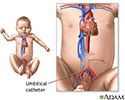Umbilical catheters
UAC; UVC
Information
The placenta is the link between mother and baby during pregnancy. Two arteries and one vein in the umbilical cord carry blood back and forth. If the newborn baby is ill right after birth, a catheter may be placed.
A catheter is a long, soft, hollow tube. An umbilical artery catheter (UAC) allows blood to be taken from an infant at different times, without repeated needle sticks. It can also be used to continuously monitor a baby's blood pressure.
An umbilical artery catheter is most often used if:
- The baby needs breathing help.
- The baby needs blood gases and blood pressure monitored.
- The baby needs strong medicines for blood pressure.
An umbilical venous catheter (UVC) allows fluids and medicines to be given without frequently replacing an intravenous (IV) line.
An umbilical venous catheter may be used if:
- The baby is very premature.
- The baby has bowel problems that prevent feeding.
- The baby needs very strong medicines.
- The baby needs exchange transfusion.
HOW ARE UMBILICAL CATHETERS PLACED?
There are normally two umbilical arteries and one umbilical vein in the umbilical cord. After the umbilical cord is cut off, the health care provider can find these blood vessels. The catheters are placed into the blood vessel, and an x-ray is taken to determine the final position. Once the catheters are in the right position, they are held in place with silk thread. Sometimes, the catheters are taped to the baby's belly area.
WHAT ARE THE RISKS OF UMBILICAL CATHETERS?
Complications include:
- Interruption of the blood flow to an organ (intestines, kidney, liver) or limb (leg or rear end)
- Blood clot along the catheter
- Infection
Blood flow and blood clot problems can be life threatening and require removal of the UAC. The NICU nurses carefully monitor your baby for these possible problems.
References
Santillanes G, Claudius I. Pediatric vascular access and blood sampling techniques. In: Roberts JR, Hedges JR, eds. Clinical Procedures in Emergency Medicine. 6th ed. Philadelphia, PA: Elsevier Saunders; 2014:chap 19.
-
Umbilical catheter - illustration
An umbilical catheter is a long, soft plastic tube (usually made of silicone) that is placed in the umbilical cord either through the umbilical artery or umbilical vein to allow IV fluids and medications to be given over an extended period of time.
Umbilical catheter
illustration
-
Umbilical catheter - illustration
An umbilical catheter is a long, soft plastic tube (usually made of silicone) that is placed in the umbilical cord either through the umbilical artery or umbilical vein to allow IV fluids and medications to be given over an extended period of time.
Umbilical catheter
illustration
Review Date: 11/19/2015
Reviewed By: Neil K. Kaneshiro, MD, MHA, Clinical Assistant Professor of Pediatrics, University of Washington School of Medicine, Seattle, WA. Also reviewed by David Zieve, MD, MHA, Isla Ogilvie, PhD, and the A.D.A.M. Editorial team.

